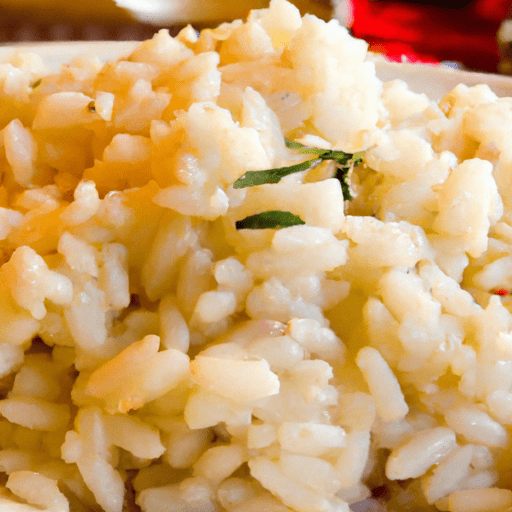The Delightful World of Cooked Risotto Rice
Risotto, a classic Italian dish, is a true culinary delight that never fails to impress. At the heart of this creamy and comforting dish lies the star ingredient - the glorious risotto rice. In this blog post, we’ll dive into the world of cooked risotto rice, exploring its taste, uses in cooking, nutritional value, and some interesting history. So grab a spoon and let’s get started!
The Taste
Cooked risotto rice has a unique and enticing flavor that sets it apart from other rice varieties. It is plump, tender, and slightly creamy, with a delicate chewy texture. When properly cooked, each grain of risotto rice maintains its distinct shape while still delivering a rich and comforting taste. The rice acts as a blank canvas, effortlessly soaking up the flavors of the ingredients it’s cooked with, resulting in a delectable combination that pleases the palate.
Common Uses in Cooking
While risotto is the most popular dish showcasing cooked risotto rice, its uses in cooking extend far beyond. Due to its creamy texture and ability to absorb flavors, risotto rice serves as an excellent base for various recipes. From creamy mushroom risotto to tantalizing seafood risotto, the possibilities are endless. Additionally, cooked risotto rice can be used to create rice salads, rice croquettes, and even rice puddings, offering a versatile ingredient that elevates any dish.
Nutritional Value
Cooked risotto rice is not just a treat for your taste buds; it also packs some nutritional value. It’s a good source of carbohydrates, providing energy for your day. Furthermore, risotto rice contains essential minerals such as magnesium and potassium, as well as vitamin B-6. Although it is not a significant source of protein, when paired with other ingredients like vegetables or lean proteins, risotto rice can contribute to a balanced and satisfying meal.
A Brief History and Interesting Facts
Risotto has a rich history that dates back to the 14th century in Italy, particularly in the Northern regions where rice cultivation thrived. The technique of slowly cooking rice with broth, resulting in a creamy consistency, was perfected over the years. Risotto became a staple in Italian cuisine and is now enjoyed globally.
Here are a few interesting facts about cooked risotto rice:
- Arborio, Carnaroli, and Vialone Nano are the most widely used varieties of risotto rice due to their high starch content, which contributes to the creamy consistency.
- The proper technique for cooking risotto involves gradually adding warm broth to the rice, allowing the liquid to absorb before adding more. This slow process encourages the release of starch, resulting in the creamy texture risotto is loved for.
- While cheese is often added to risotto, it doesn’t overpower the dish. Instead, it contributes to the overall creaminess and enhances the flavor.
- Risotto is traditionally served as a primo (first course) in Italian cuisine. However, it can also be enjoyed as a main course or a side dish, depending on the occasion and preferences.
So next time you’re in the mood for a comforting, flavorful dish, consider cooking up a batch of risotto rice. With its unique taste, versatility in the kitchen, and fascinating history, it’s no wonder why cooked risotto rice continues to captivate food lovers across the globe.
Now armed with a deeper appreciation for cooked risotto rice, let your culinary creativity bloom and indulge in this Italian masterpiece. Buon appetito!
Cooked Risotto Rice:
Origin: Risotto rice, also known as arborio rice, is a type of short-grain rice that originated in Italy. It is specifically cultivated and processed to give it the characteristic creamy texture required for making risotto.
Common Uses: Cooked risotto rice is primarily used to make risotto, a traditional Italian dish known for its rich and creamy consistency. However, it can also be used in other recipes like rice pudding, rice salads, or as a side dish.
Nutritional Benefits: Cooked risotto rice provides a reasonable amount of carbohydrates, which are a significant energy source for the body. It also contains small amounts of protein and dietary fiber. However, most of its original nutritional content may diminish during the cooking process.
Unique Properties: Risotto rice has a higher starch content compared to other types of rice, like long-grain rice. When cooked, the starch is released, creating the creamy texture characteristic of risotto. The grains are plump and absorb liquid well, allowing flavors to meld together.
Historical Significance: Risotto as a dish dates back to the 14th century in Italy. Initially, it was considered a luxury food, as rice was a commodity. Over time, risotto became more popular throughout Italy and gained international recognition as a classic Italian specialty. Today, different regions in Italy have their own variations of risotto, showcasing the versatility of the dish.




Use the share button below if you liked it.
It makes me smile, when I see it.